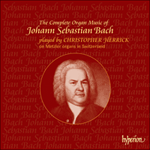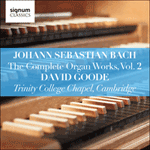
Welcome to Hyperion Records, an independent British classical label devoted to presenting high-quality recordings of music of all styles and from all periods from the twelfth century to the twenty-first.
Hyperion offers both CDs, and downloads in a number of formats. The site is also available in several languages.
Please use the dropdown buttons to set your preferred options, or use the checkbox to accept the defaults.

| David Goode (organ)» More |
Schweitzer’s claim that Corelli, among others, taught Bach ‘plasticity of musical structure’ seems hard to accept in relation to BWV579, where the lesson seems already well learnt from other sources. Corelli’s original is expanded from a mere thirty-nine bars to one hundred and two, with a fourth part or ‘voice’ added and the bass allocated to the pedals. The resultant fugue is of the ‘canzona’ type, with interest deriving almost exclusively from the subjects themselves. BWV579 abandons Corelli’s regular distribution of ‘stretti’ (overlapping entries of subject material) in order to achieve a concentration of this effect towards the end, where possibilities are perceived which were not open to Corelli with his three- ’voice’ arrangement. In view of the immense discrepancies between original and ‘arrangement’ in this case, the latter cannot be considered a true transcription in the same sense as the Vivaldi and Ernst items.
from notes by Francis Pott © 1995
Schweitzers Behauptung, daß Corelli und andere Bach ‘Plastizität der musikalischen Struktur’ gelehrt hätten, kann man in bezug auf BWV579 nur schwer akzeptieren, daß Bach hier die Lektion bereits gut aus anderen Quellen gelernt zu haben scheint. Corellis Original wurde von bloß neununddreißig Takten auf einhundertundzwei erweitert, außerdem wurde ihm eine vierte Stimme hinzugefügt und die Baßstimme den Pedalen zugewiesen. Die sich daraus ergebende Fuge gehört zum Typus der Kanzone, welche ihr Interesse fast ausschließlich aus den Themen selbst zieht. BWV579 verläßt Corellis regelmäßige Verteilung von ‘stretti’ (sich überschneidende Einsätze thematischen Materials), um sich gegen Schluß gerade auf diesen Effekt zu konzentrieren: es werden dort Möglichkeiten erkannt, die Corelli mit seinem dreistimmigen Arrangement nicht offenstanden. In Anbetracht der unermeßlichen Kluft, die in diesem Falle zwischen Original und ‘Bearbeitung’ besteht, kann das letztere nicht als echte Transkription im Sinne der Vivaldi- und Ernst-Stücke betrachtet werden.
aus dem Begleittext von Francis Pott © 1995
Deutsch: Angelika Malbert
 Bach: The Complete Organ Works Bach: The Complete Organ Works‘Let me say without hesitation that Herrick’s performances are models of clarity, accuracy, precision and musicality … this is a complete Bach th ... ‘Herrick is one of the few organists who does justice to these difficult, elusive pieces … What a singular joy to hear the organ played with such ...» More |
 Bach: The Complete Organ Works, Vol. 2 Bach: The Complete Organ Works, Vol. 2David Goode presents a second album in his cycle of the complete Bach organ works, once more exploring the sounds of the 1976 Metzler organ of Trinity College Cambridge.» More |

